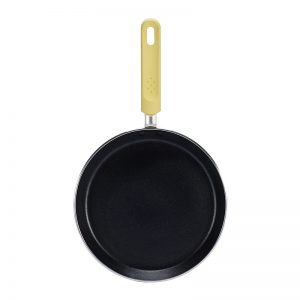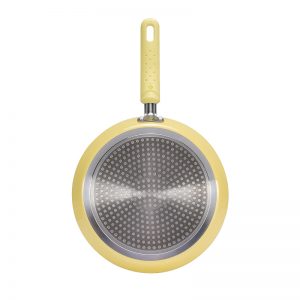Teach you to distinguish the quality of non-stick pan
(1) Selection of non-stick coating
There have been five generations of non-stick coatings from the invention to the present: the first generation is Teflon; the second generation is Teflon with improved functions; the third generation is called Silverstone; the fourth generation is Super Silverstone; the fifth generation is “Autograph”. Generally speaking, if the manufacturing is normal, the new-generation paint will perform better than the old-generation paint.
(2) Selection of pot raw materials
There are four raw materials for non-stick pans: iron, aluminum, stainless steel and alloy steel.
1. There are two types of iron products: pig iron and wrought iron. Pig iron products are made of forging, thick and heavy, but have a large heat capacity and are not easy to overheat; wrought iron products are thinner and have a small heat capacity. Both have the shortcomings of being easy to rust and easy to be corroded by acid and alkali, so the life span is shorter.
2. The benefits of aluminum products are light weight and fast heat conduction. The disadvantage is that they will react chemically with foods with strong acidity and alkalinity and shorten the service life. The oxidation products may make people feel unclean.
3. Stainless steel products have the benefits of acid and alkali resistance, no rust, high temperature resistance, not easy to oxidize, and long service life, but the price is more expensive.
4. Alloy products generally also have the function of stainless steel, but the price is higher, and it contains certain elements that are unlucky for the health of the body.
(3) Inspection of non-stick and easy-to-clean functions of pots and pans
To distinguish whether the non-stick pan is qualified or not, you can do a simple non-stick test: when the non-stick pan is burned to 1500C to 1700C, beat the fresh eggs into the pan, do not put the oil, turn the pan over until it condenses, the eggs can fall freely If it is, it is a passing grade; otherwise, it is a non-stick pan. When consumers buy non-stick pan products, they should first check the appearance quality of the coating. The appearance of the coating should be uniform in color, shiny, and without exposed substrate. Second, see if the coating is continuous, that is, there are no mud cracks. The third is to gently peel off the marginal coating of the pan with your nails. There should be no lumps of coating falling off, indicating that the coating has a good bond with the substrate. 4. Use your fingernail to lightly scratch the surface of the coating. There should be no deep grooves on the surface of the coating, which indicates that the surface of the coating has a better hardness. Fifth, pour a few drops of water into the non-stick pan. If the water droplets can flow like beads on the lotus leaf, and there is no water mark after the water droplets flow through, it means that the pan is non-stick, otherwise it is made with other materials Fake non-stick pan.
(4) Protection measures
1. Wash and dry the new pot first, and apply a thin layer of oil on the surface of the pot to improve its non-stick function.
2. It should not be used in large fires, otherwise it is easy to cause the withering of non-stick coatings. The fire should not rise from the bottom of the pot.
3. Wash and decontaminate immediately after use, but after the temperature of the pot has dropped, wash it with clean water (or add detergent), wipe gently with a sponge or soft cloth, and it is not suitable to use rough objects or iron brushes. Clean, to prevent scratching the non-stick coating, which constitutes its damage and decay.








